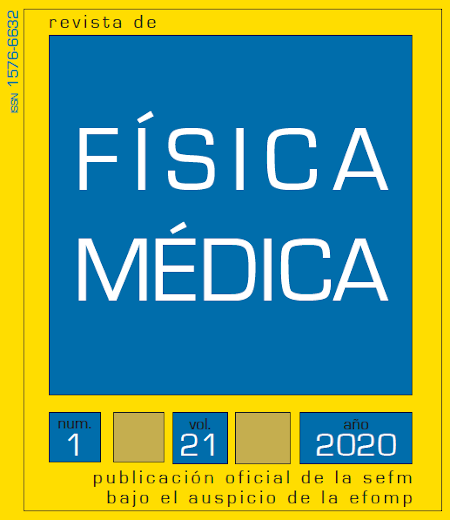Basic requirements for systems of dose management and recording in imaging diagnostic examinations
DOI:
https://doi.org/10.37004/sefm/2020.21.1.004Keywords:
dose recording, optimization, reference levels for the diagnosis, dose indicator devicesAbstract
Directive 2013/59/Euratom of 5 December 2013 laying down basic safety standards for protection against the dangers arising from exposure to ionising radiation, establishes in section 28 of its introduction that more strict requirements should be proposed in what information to patients, recording and notification of doses in medical procedures, use of reference levels for diagnosis (RLD) and availability of dose indicator devices concerns. Due to the development of said concepts in both the European and Spanish regulation (Real Decreto 601/2019 of 18 October 2019 about justification and optimization of the use of ionising radiation for radiological protection in medical exposures) the Spanish Societies of Radiological Protection (SEPR) and Medical Physics (SEFM) have created a work group whose task is to make a report describing the requirements that a system for the recording and management of doses should fulfil.
References
Brenner D, Elliston C, Hall E, Berdon W. Estimated Risks of Radiation-Induced Fatal Cancer from Pediatric CT. AJR Am. J. Roentgenol. 2001;176(2):289-96.
Miglioretti D, Johnson E, Williams A, Greenlee R, Weinmann S, Solberg L et al. The Use of Computed Tomography in Pediatrics and the Associated Radiation Exposure and Estimated Cancer Risk. JAMA Pediatr. 2013;167(8):700-7.
Thrall J. Radiation Exposure in CT Scanning and Risk: Where Are We?. Radiology. 2012;264(2):325-8.
Mettler F, Bhargavan M, Faulkner K, Gilley D, Gray J, Ibbott G et al. Radiologic and Nuclear Medicine Studies in the United States and Worldwide: Frequency, Radiation Dose, and Comparison with Other Radiation Sources—1950–2007. Radiology. 2009;253(2):520-31.
Smith-Bindman R, Miglioretti D, Johnson E, Lee C, Feigelson H, Flynn M et al. Use of Diagnostic Imaging Studies and Associated Radiation Exposure for Patients Enrolled in Large Integrated Health Care Systems, 1996-2010. JAMA. 2012;307(22):2400-9.
SPR, AAPM, ACR, ASRT. Image Gently [acceso: 03/10/2019]. Disponible en http://www.imagegently.org/
ACR,RSNA,ASRT,AAPM.ImageWisely.[acceso:03/10/2019]. Disponible en http://www.imagewisely.org/.
European Commission (EC). Guidance on Diagnostic Reference Levels (DRLs) for medical exposures, Radiation Protection 109. 1999.
ICRP. Diagnostic Reference Levels in Medical Imaging: Review and additional advice. ICRP Supporting Guidance 2. Ann ICRP 2001;31(4):33-52.
IAEA. Establishing guidance levels In X ray guided medical interventional procedures: A pilot study. Safety Reports Series No. 59. Vienna: International Atomic Energy Agency; 2009.
IAEA. Diagnostic Reference Levels (DRLs). [Internet]. [Acceso 3/10/2019]. Disponible en: https://www.iaea.org/resources/rpop/health-professionals/radiology/diagnostic-reference-levels/about-diagnostic-reference-levels
Vano E, Miller D, Martin C, Rehani M, Kang K, Rosenstein M et al. ICRP Publication 135: Diagnostic Reference Levels in Medical Imaging. Annals of the ICRP. 2017. 46(1):1-144.
NEMA PS3 / ISO 12052, Digital Imaging and Communications in Medicine (DICOM) Standard, National Electrical Manu facturers Association, Rosslyn, VA, USA [Internet]. [Acceso 3/10/2019]. Disponible en: https://www.dicomstandard.org/.
Malone J, Guleria R, Craven C, Horton P, Järvinen H, Mayo J et al. Justification of diagnostic medical exposures: some practical issues. Report of an International Atomic Energy Agency Consultation. Br J Radiol. 2012; 85(1013):523-538.
Comisión Europea. Dirección General de Medio Ambiente. PR 118: Guía de indicaciones para la correcta solicitud de pruebas de diagnóstico por imagen. Luxemburgo : OFICINA DE PUBLICACIONES OFICIALES DE LAS COMUNIDADES EUROPEAS, 2000.
Sociedad Española de Radiología Médica. SERAM: Recomendaciones de “no hacer”. [Internet] [Acceso: 03/10/2019]. Disponible en: https://seram.es/images/site/doc_seram_recom_no_hacer.pdf
Sistrom C, Dang P, Weilburg J, Dreyer K, Rosenthal D, Thrall J. Effect of Computerized Order Entry with Integrated Decision Support on the Growth of Outpatient Procedure Volumes: Seven-year Time Series Analysis. Radiology.2009; 251(1):147-55.
Hricak H, Brenner D, Adelstein S, Frush D, Hall E, Howell R et al. Managing Radiation Use in Medical Imaging: A Multifaceted Challenge. Radiology. 2011; 258(3):889-905.
International Commission on Radiation Protection (ICRP). Recommendations of the International Commission on Radiological Protection. ICRP Publication 60. 1991. Ann. ICRP 21(1-3).
International Commission on Radiation Protection (ICRP). The 2007 Recommendations of the International Commission on Radiological Protection. ICRP 103. Ann ICRP 2007; 37: 2-4. Disponible en: http://www.icrp.org/docs/P103_Spanish.pdf
Boletín Oficial del Estado (BOE). DIRECTIVA 2013/59/ EURATOM DEL CONSEJO de 5 de diciembre de 2013 por la que se establecen normas de seguridad básicas para la protección contra los peligros derivados de la exposición a radiaciones ionizantes, y se derogan las Directivas 89/618/ Euratom, 90/641/Euratom, 96/29/Euratom, 97/43/Euratom y 2003/122/Euratom.
European Commission (EC). Radiation Protection nº185. European Guidelines on Diagnostic Reference Levels for Paediatric Imaging. s.l. : Luxembourg: Publications Office of the European Union, 2018. ISSN 2315-2826.
Moore B, Brady S, Mirro A and Kaufman R. Size-specific dose estimate (SSDE) provides a simple method to calculate organ dose for pediatric CT examinations. Med Phys. 2014, 41(7).
Rehani MM, Srimahachota S. Skin injuries in interventional procedures. Radiat Prot Dosimetry, 2011;147(1-2):8-12.
Balter S, Miller DL. Patient skin reactions from interventional fluoroscopy procedures. American Journal of Roentgenology, 2014;202(4):W335-42.
International Electrotechnical Commission (IEC). IEC 60601 - General requirements for basic safety and essential perfomance. 2005.
The European Federation of Organisations for MedicalPhysics (EFOMP). EFOMP Guidelines on the transposition of EU BSS art. 60 in national. 2018.




